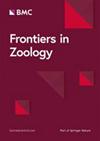Nest site selection and fidelity of European pond turtle (Emys orbicularis) population of Babat Valley (Gödöllő, Hungary)
IF 2.6
2区 生物学
Q1 ZOOLOGY
引用次数: 0
Abstract
The conservation of aquatic and semiaquatic turtles requires knowledge of the area and vegetation structure of habitat used for nesting, and nesting migration route. We aimed to survey the effects of habitat features to the nest site selection, nesting success, and test the possibility of nest site fidelity. Our study was carried out at 10 different nesting areas, with special emphasis on data from returning females in a pond system in Hungary between 2014 and 2017. Most nesting attempts were found in closed sand steppes, uncharacteristic dry and semi-dry grasslands habitat patches. The principal component analysis (PCA) showed that increased sandy soil cover, sunlight and slope were important variables in nest site choice. The increasing PCA first axis score significantly increased the chance of an emergence. The degradation of open steppe vegetation, occurrence of weeds, invasive and disturbance tolerant species have a negative effect on the selection of nest sites. We observed that 96.55% of nests were located within 20 m south of a pine forest at preferred nest site at pond 5, which provided the right incubation temperature through partial shading. The returning females nested significantly closer to the northern pine forest than the single clutch females. Most probably the returning females already has the necessary experience to select the right nesting site. The individually marked females did not choose new nesting areas during the monitored years which suggests nesting area fidelity, but we did not find nest site fidelity. The maintenance of mosaic habitat structure, slowing down the succession process at the nesting area should be basic priorities in European pond turtle conservation programs. We suggested a spatial and temporal scheduling of land management and agricultural work to the local farmers. If the actual nest site is in an agricultural area, all work should be avoided throughout the year. Agricultural machinery should avoid the migration routes of adult turtles and emerged hatchlings during the concerned period. Under strong predation pressure, predator control should be carried out, and use nest protection.巴巴特山谷(匈牙利 Gödöllő 地区)欧洲池龟(Emys orbicularis)种群的巢址选择和忠诚度
保护水龟和半水龟需要了解筑巢栖息地的面积和植被结构以及筑巢迁徙路线。我们的目的是调查栖息地特征对筑巢地点选择和筑巢成功率的影响,并测试筑巢地点忠诚度的可能性。我们的研究在10个不同的筑巢区进行,重点是2014年至2017年期间在匈牙利一个池塘系统中从返回的雌鸟那里获得的数据。大多数筑巢尝试都是在封闭的沙质草原、非典型的干旱和半干旱草原生境斑块中进行的。主成分分析(PCA)显示,沙质土壤覆盖率增加、日照和坡度是筑巢地点选择的重要变量。PCA 第一轴得分越高,出现的几率就越大。开阔草原植被退化、杂草丛生、入侵物种和耐干扰物种对巢址选择有负面影响。我们观察到,96.55%的巢位于5号池塘首选巢址松林以南20米范围内,松林通过部分遮荫提供了适宜的孵化温度。与单窝雌鸟相比,返巢雌鸟的巢明显更靠近北部松林。回归雌鸟很可能已经具备了选择正确筑巢地点的必要经验。在监测年份中,单个标记的雌鸟没有选择新的筑巢区,这表明筑巢区是忠实的,但我们没有发现筑巢地点是忠实的。在欧洲池龟保护计划中,维持马赛克栖息地结构、减缓筑巢区的演替过程应该是基本优先事项。我们建议当地农民对土地管理和农业工作进行时空调度。如果实际筑巢地点位于农业区,则应全年避免所有工作。在相关时期,农业机械应避开成龟和幼龟的迁徙路线。在强大的捕食压力下,应进行捕食控制,并使用巢穴保护。
本文章由计算机程序翻译,如有差异,请以英文原文为准。
求助全文
约1分钟内获得全文
求助全文
来源期刊

Frontiers in Zoology
ZOOLOGY-
CiteScore
4.90
自引率
0.00%
发文量
29
审稿时长
>12 weeks
期刊介绍:
Frontiers in Zoology is an open access, peer-reviewed online journal publishing high quality research articles and reviews on all aspects of animal life.
As a biological discipline, zoology has one of the longest histories. Today it occasionally appears as though, due to the rapid expansion of life sciences, zoology has been replaced by more or less independent sub-disciplines amongst which exchange is often sparse. However, the recent advance of molecular methodology into "classical" fields of biology, and the development of theories that can explain phenomena on different levels of organisation, has led to a re-integration of zoological disciplines promoting a broader than usual approach to zoological questions. Zoology has re-emerged as an integrative discipline encompassing the most diverse aspects of animal life, from the level of the gene to the level of the ecosystem.
Frontiers in Zoology is the first open access journal focusing on zoology as a whole. It aims to represent and re-unite the various disciplines that look at animal life from different perspectives and at providing the basis for a comprehensive understanding of zoological phenomena on all levels of analysis. Frontiers in Zoology provides a unique opportunity to publish high quality research and reviews on zoological issues that will be internationally accessible to any reader at no cost.
The journal was initiated and is supported by the Deutsche Zoologische Gesellschaft, one of the largest national zoological societies with more than a century-long tradition in promoting high-level zoological research.
 求助内容:
求助内容: 应助结果提醒方式:
应助结果提醒方式:


